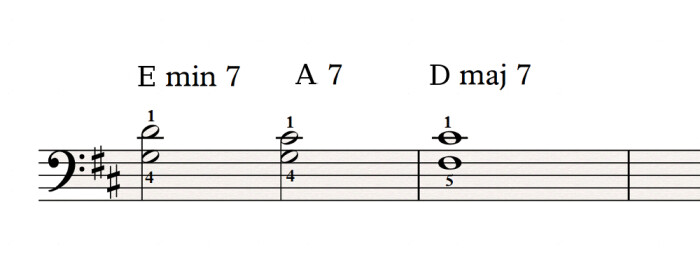As you already saw, due to orchestration (delegating the root to the instrument carrying the bass line) or simplification (making voicings lighter), you can take away all sort of notes from your voicings, according to your needs. At the same time, in the last couple of articles, I have striven to present to you more concrete examples of the theoretical concepts we've seen, with a practical application on the piano. This necessarily leads to new forms of voicing modifications. And, as you'll see, chord progressions on the piano were never so easy!

Replacing the root with the fifth
Let’s rewind a bit to the building of voicings and reinsert the root into the voicing you will play on the piano. As you know, the coherent connection of chords often entails the use of inversions. Indeed, but that’s sometimes not enough!
Take the following example:

You have a pretty banal II-V-I. It’s three seventh chords whose fifth we have suppressed to begin lightening the harmonization. However, the voice-leading in the two lower voices is not entirely satisfying (ascending conjoint parallel movement and then descending disjoint parallel movement). Not to mention that it’s not ergonomically comfortable. To improve things, I propose to bring back the fifth of the D7 chord and take out the root. So you add an A and take out the D.
This is what you get:

The stability of the progression is reinforced, especially due to the lower voices which have greatly reduced their motion. And this is actually reduced to a descending conjoint parallel motion between the last two chords. And you can also see that in terms of fingering, the progression of the different chords is much more smoother and coherent.
Here’s the same with a right-hand fingering:
Seventh chords with two sounds
To finish, let’s go back to voicings based on seventh chords without root, or whose root has been entrusted to another instrument. Now reduce them to their bare minimum, two notes: the third and the seventh of each chord. You probably recall that, apart from the root, these degrees are the ones that characterize a seventh chord (see article 35).
In the following example, you’ll see how to fabricate a II-V-I cadence (a half cadence followed by a perfect cadence) with a two-note chord progression, while at the same time being comfortable playing them at the piano.

The voice-leading is very compact, with no key range change. You only have a simple descending conjoint motion in the upper voice between the first and second chords, followed by a similar motion between the second and third chords.
Here you have the same for the right hand:





